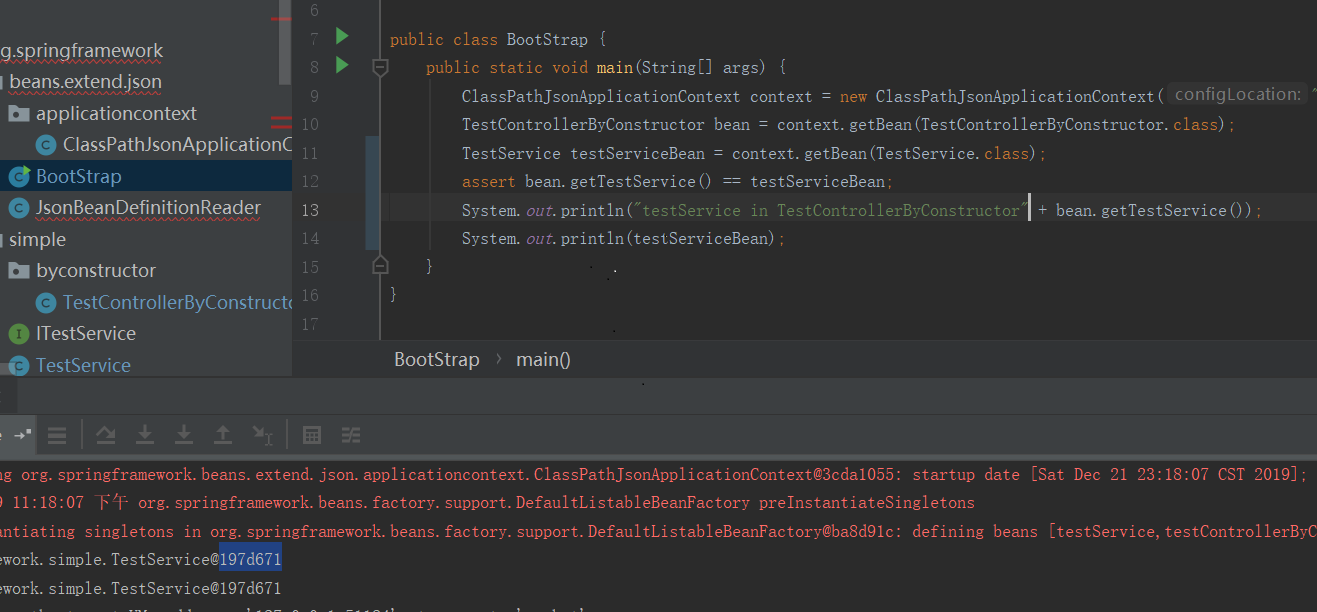曹工说Spring Boot源码(4)-- 我是怎么自定义ApplicationContext,从json文件读取bean definition的?
写在前面的话
相关背景及资源:
曹工说Spring Boot源码系列开讲了(1)-- Bean Definition到底是什么,附spring思维导图分享
工程结构图:

大体思路
总体来说,bean definition是什么,我们前面几讲,说了个大概了;目前,我们将聚焦于怎么获取bean definition。
我们这次做个实验,就是将bean definition(一共两个bean,有依赖关系,依赖是手动指定的)定义在json文件内,然后自定义一个applicationcontext,从该文件内读取bean definiton,最后我们测试下是否能work。
注意哈,这里的依赖,依然和前面讲的一样,都是手动指定依赖,类似@Autowired这种,还会放到后面才会讲,开车也要先学手动档嘛,是伐?
建议大家直接拖源码下来看:
定义json文件
json文件内,要表达bean definition,按照我们前面说的,基本就包括几个必要的就行了,比如beanClassName。但我这里还是展示一个完整的,但我也是用fastjson先在之前的工程里生成了一个json,之后再拷贝到了json文件里:
// 这里获取到的bean definition的实际类型是 GenericBeanDefiniton,所以序列化出来的的json,就是一个// GenericBeanDefiniton集合的jsonList<BeanDefinition> beanDefinitionList = factory.getBeanDefinitionList()JSON.toJSONString(beanDefinitionList)
json文件内容如下:
[{"abstract": false,"autowireCandidate": true,"autowireMode": 0,"beanClass": "org.springframework.simple.TestService","beanClassName": "org.springframework.simple.TestService","constructorArgumentValues": {"argumentCount": 0,"empty": true,"genericArgumentValues": [],"indexedArgumentValues": {}},"dependencyCheck": 0,"enforceDestroyMethod": true,"enforceInitMethod": true,"lazyInit": false,"lenientConstructorResolution": true,"methodOverrides": {"empty": true,"overrides": []},"nonPublicAccessAllowed": true,"primary": false,"propertyValues": {"converted": false,"empty": true,"propertyValueList": [],"propertyValues": []},"prototype": false,"qualifiers": [],"resolvedAutowireMode": 0,"role": 0,"scope": "","singleton": true,"synthetic": false},{"abstract": false,"autowireCandidate": true,"autowireMode": 0,"beanClass": "org.springframework.simple.byconstructor.TestControllerByConstructor","beanClassName": "org.springframework.simple.byconstructor.TestControllerByConstructor","constructorArgumentValues": {"argumentCount": 2,"empty": false,"genericArgumentValues": [],"indexedArgumentValues": {0: {"converted": false,"value": {"beanName": "testService","toParent": false}},1: {"converted": false,"value": "wire by constructor"}}},"dependencyCheck": 0,"enforceDestroyMethod": true,"enforceInitMethod": true,"lazyInit": false,"lenientConstructorResolution": true,"methodOverrides": {"empty": true,"overrides": []},"nonPublicAccessAllowed": true,"primary": false,"propertyValues": {"converted": false,"empty": true,"propertyValueList": [],"propertyValues": []},"prototype": false,"qualifiers": [],"resolvedAutowireMode": 0,"role": 0,"scope": "","singleton": true,"synthetic": false}]
大家可能看得有点懵,其实换成xml,就是类似下面这样的:
<bean name="testService" class="org.springframework.simple.TestService" /><bean id="testController" class="org.springframework.simple.TestController"><constructor-arg ref="testService"/></bean>
扩展 applicationContext
package org.springframework.beans.extend.json.applicationcontext;import org.springframework.beans.BeansException;import org.springframework.beans.extend.json.JsonBeanDefinitionReader;import org.springframework.beans.factory.support.DefaultListableBeanFactory;import org.springframework.beans.factory.xml.ResourceEntityResolver;import org.springframework.beans.factory.xml.XmlBeanDefinitionReader;import org.springframework.context.ApplicationContext;import org.springframework.context.support.AbstractRefreshableConfigApplicationContext;import java.io.IOException;public class ClassPathJsonApplicationContext extends AbstractRefreshableConfigApplicationContext {@Overrideprotected void loadBeanDefinitions(DefaultListableBeanFactory beanFactory) throws BeansException, IOException {//其实主要内容和xmlapplicationcontext是一样的,主要就是下面这行不一样,new了一个json readerJsonBeanDefinitionReader beanDefinitionReader = new JsonBeanDefinitionReader(beanFactory);beanDefinitionReader.setEnvironment(this.getEnvironment());beanDefinitionReader.setResourceLoader(this);// 这里通过json bean definiton reader去读取bean definitionloadBeanDefinitions(beanDefinitionReader);}/***通过json bean definiton reader去读取bean definition**/protected void loadBeanDefinitions(JsonBeanDefinitionReader reader) throws BeansException, IOException {// 这里获取json文件的path,这个location是在new ClassPathJsonApplicationContext时传进来的String[] configResources = getConfigLocations();if (configResources != null) {reader.loadBeanDefinitions(configResources);}}public ClassPathJsonApplicationContext(String configLocation) throws BeansException {this(new String[] {configLocation}, true, null);}/*** 这里一模一样,不需要任何变化**/public ClassPathJsonApplicationContext(String[] configLocations, boolean refresh, ApplicationContext parent)throws BeansException {super(parent);setConfigLocations(configLocations);if (refresh) {refresh();}}}
扩展jsonBeanDefinitionReader
package org.springframework.beans.extend.json;import com.alibaba.fastjson.JSON;import com.alibaba.fastjson.JSONObject;import lombok.extern.slf4j.Slf4j;import org.springframework.beans.factory.BeanDefinitionStoreException;import org.springframework.beans.factory.config.ConstructorArgumentValues;import org.springframework.beans.factory.config.RuntimeBeanReference;import org.springframework.beans.factory.support.AbstractBeanDefinitionReader;import org.springframework.beans.factory.support.BeanDefinitionRegistry;import org.springframework.beans.factory.support.BeanNameGenerator;import org.springframework.beans.factory.support.GenericBeanDefinition;import org.springframework.context.annotation.AnnotationBeanNameGenerator;import org.springframework.core.NamedThreadLocal;import org.springframework.core.io.ClassPathResource;import org.springframework.core.io.Resource;import org.springframework.core.io.support.EncodedResource;import org.springframework.core.io.support.PathMatchingResourcePatternResolver;import org.springframework.util.CollectionUtils;import org.springframework.util.StreamUtils;import org.xml.sax.InputSource;import java.io.IOException;import java.io.InputStream;import java.nio.charset.Charset;import java.util.*;/*** 类似* {@link org.springframework.beans.factory.xml.XmlBeanDefinitionReader}* 只是本类是去json文件里读取bean definition**/@Slf4jpublic class JsonBeanDefinitionReader extends AbstractBeanDefinitionReader {private final ThreadLocal<Set<EncodedResource>> resourcesCurrentlyBeingLoaded =new NamedThreadLocal<Set<EncodedResource>>("json bean definition resources currently being loaded");public JsonBeanDefinitionReader(BeanDefinitionRegistry registry) {super(registry);}@Overridepublic int loadBeanDefinitions(Resource resource) throws BeanDefinitionStoreException {// 以下照抄xmlbeanDefintionReader开始Set<EncodedResource> currentResources = this.resourcesCurrentlyBeingLoaded.get();if (currentResources == null) {currentResources = new HashSet<EncodedResource>(4);this.resourcesCurrentlyBeingLoaded.set(currentResources);}EncodedResource encodedResource = new EncodedResource(resource);if (!currentResources.add(encodedResource)) {throw new BeanDefinitionStoreException("Detected cyclic loading of " + encodedResource + " - check your import definitions!");}//照抄xmlbeanDefintionReader结束//这里的encodedResource.getResource()就是我们的json文件,这里通过spring core里面的一个工具类读取为InputStreamString json = null;try (InputStream inputStream = encodedResource.getResource().getInputStream()) {json = StreamUtils.copyToString(inputStream, Charset.forName("UTF-8"));} catch (IOException e) {log.error("{}",e);return 0;} finally {currentResources.remove(encodedResource);if (currentResources.isEmpty()) {this.resourcesCurrentlyBeingLoaded.remove();}}//熟悉的fastjson,熟悉的味道List<GenericBeanDefinition> list = JSON.parseArray(json, GenericBeanDefinition.class);if (CollectionUtils.isEmpty(list)) {return 0;}/*** 1:因为GenericBeanDefinition,只有setBeanClassName,所以bean反序列化时,只序列化了这个字 * 段;实际我们知道,beanClass很重要,所以我们只能自己处理一下了* 2:第二个问题,我们在下面解释**/for (GenericBeanDefinition genericBeanDefinition : list) {/*** 1、处理beanClass*/Class<?> clazz = null;try {clazz = Thread.currentThread().getContextClassLoader().loadClass(genericBeanDefinition.getBeanClassName());} catch (ClassNotFoundException e) {log.error("bean class cant be load for beandefinition: {}",genericBeanDefinition);throw new RuntimeException();}genericBeanDefinition.setBeanClass(clazz);/*** 2、处理constructor问题,因为Object value = valueHolder.getValue();* 是Object类型,但这个实际是一个可变类型,当构造器参数为String类型时,这个Object就是 * String类型的,当构造器参数类型为其他bean的引用时,这个object就是RuntimeBeanReference * 的,* 因为fastjson把我的object转成jsonobject类型了,所以这里要手动搞成RuntimeBeanReference*/ConstructorArgumentValues constructorArgumentValues = genericBeanDefinition.getConstructorArgumentValues();if (constructorArgumentValues.isEmpty()) {continue;}Map<Integer, ConstructorArgumentValues.ValueHolder> map = constructorArgumentValues.getIndexedArgumentValues();if (CollectionUtils.isEmpty(map)) {continue;}for (ConstructorArgumentValues.ValueHolder valueHolder : map.values()) {Object value = valueHolder.getValue();if (value instanceof JSONObject) {JSONObject jsonObject = (JSONObject) value;RuntimeBeanReference runtimeBeanReference = jsonObject.toJavaObject(RuntimeBeanReference.class);valueHolder.setValue(runtimeBeanReference);}}}//这里new一个BeanNameGenerator,这是自带的setBeanNameGenerator(new AnnotationBeanNameGenerator());BeanNameGenerator beanNameGenerator = getBeanNameGenerator();// 获取BeanDefinitionRegistry,bean factory默认实现了BeanDefinitionRegistryBeanDefinitionRegistry registry = getRegistry();//注册bean definition到BeanDefinitionRegistry里面去for (GenericBeanDefinition genericBeanDefinition : list) {String beanName = beanNameGenerator.generateBeanName(genericBeanDefinition, registry);registry.registerBeanDefinition(beanName,genericBeanDefinition);}return list.size();}}
收工了,测试一下
public class BootStrap {public static void main(String[] args) {// new一个我们的自定义json上下文ClassPathJsonApplicationContext context = new ClassPathJsonApplicationContext("beanDefinition.json");// getBean试一下TestControllerByConstructor bean = context.getBean(TestControllerByConstructor.class);System.out.println(bean);}}

可以看到,已经注入进去了。没有什么问题。
总结
今天比较晚,写得也比较急,有问题的话,请大家务必指出,谢谢大家
源码地址:
曹工说Spring Boot源码(4)-- 我是怎么自定义ApplicationContext,从json文件读取bean definition的?的更多相关文章
- 曹工说Spring Boot源码系列开讲了(1)-- Bean Definition到底是什么,附spring思维导图分享
写在前面的话&&About me 网上写spring的文章多如牛毛,为什么还要写呢,因为,很简单,那是人家写的:网上都鼓励你不要造轮子,为什么你还要造呢,因为,那不是你造的. 我不是要 ...
- 曹工说Spring Boot源码(2)-- Bean Definition到底是什么,咱们对着接口,逐个方法讲解
写在前面的话 相关背景及资源: 曹工说Spring Boot源码系列开讲了(1)-- Bean Definition到底是什么,附spring思维导图分享 工程代码地址 思维导图地址 工程结构图: 正 ...
- 曹工说Spring Boot源码(3)-- 手动注册Bean Definition不比游戏好玩吗,我们来试一下
写在前面的话 相关背景及资源: 曹工说Spring Boot源码系列开讲了(1)-- Bean Definition到底是什么,附spring思维导图分享 工程代码地址 思维导图地址 工程结构图: 大 ...
- 曹工说Spring Boot源码(5)-- 怎么从properties文件读取bean
写在前面的话 相关背景及资源: 曹工说Spring Boot源码(1)-- Bean Definition到底是什么,附spring思维导图分享 曹工说Spring Boot源码(2)-- Bean ...
- 曹工说Spring Boot源码(6)-- Spring怎么从xml文件里解析bean的
写在前面的话 相关背景及资源: 曹工说Spring Boot源码(1)-- Bean Definition到底是什么,附spring思维导图分享 曹工说Spring Boot源码(2)-- Bean ...
- 曹工说Spring Boot源码(7)-- Spring解析xml文件,到底从中得到了什么(上)
写在前面的话 相关背景及资源: 曹工说Spring Boot源码(1)-- Bean Definition到底是什么,附spring思维导图分享 曹工说Spring Boot源码(2)-- Bean ...
- 曹工说Spring Boot源码(8)-- Spring解析xml文件,到底从中得到了什么(util命名空间)
写在前面的话 相关背景及资源: 曹工说Spring Boot源码(1)-- Bean Definition到底是什么,附spring思维导图分享 曹工说Spring Boot源码(2)-- Bean ...
- 曹工说Spring Boot源码(9)-- Spring解析xml文件,到底从中得到了什么(context命名空间上)
写在前面的话 相关背景及资源: 曹工说Spring Boot源码(1)-- Bean Definition到底是什么,附spring思维导图分享 曹工说Spring Boot源码(2)-- Bean ...
- # 曹工说Spring Boot源码(10)-- Spring解析xml文件,到底从中得到了什么(context:annotation-config 解析)
写在前面的话 相关背景及资源: 曹工说Spring Boot源码(1)-- Bean Definition到底是什么,附spring思维导图分享 曹工说Spring Boot源码(2)-- Bean ...
随机推荐
- jinjia2
ansible-playbook --become --become-method=su -K copy.yml - hosts: web remote_user: ansible tasks: - ...
- php基础文档
目录 PHP简介 PHP概述和名词解释 PHP常见数据类型 PHP运算符 PHP流程控制语句 PHP函数 PHP类与对象 PHP会话session与缓存cookie(扩展) 1.PHP简介 PHP,即 ...
- C#Windows Forms 计算器--xdd
一.计算器 using System; using System.Collections.Generic; using System.ComponentModel; using System.Data ...
- SpringBoot系列之集成Thymeleaf用法手册
目录 1.模板引擎 2.Thymeleaf简介 2.1).Thymeleaf定义 2.2).适用模板 3.重要知识点 3.1).th:text和th:utext 3.2).标准表达式 3.3).Thy ...
- 基于 HTML5 + WebGL 的地铁 3D 可视化系统
前言 工业互联网,物联网,可视化等名词在我们现在信息化的大背景下已经是耳熟能详,日常生活的交通,出行,吃穿等可能都可以用信息化的方式来为我们表达,在传统的可视化监控领域,一般都是基于 Web SCAD ...
- 关于HashMap容量的初始化,还有这么多学问。
在<HashMap中傻傻分不清楚的那些概念>文章中,我们介绍了HashMap中和容量相关的几个概念,简单介绍了一下HashMap的扩容机制. 文中我们提到,默认情况下HashMap的容量是 ...
- 09-kubernetes StatefulSet
目录 StatefulSet 简单测试 使用 StatefulSet 创建基础的PV StatefulSet 清单 StatefulSet 有状态应用副本集 无状态的, 更关注的是群体 有状态的, 更 ...
- 利用scatter()绘制颜色映射的二次方曲线
程序如下: import matplotlib.pyplot as plt x_value = list(range(1, 1001)) y_value = [x**2 for x in x_valu ...
- 关于layer的基本所有的事件全部失效问题
只要在页面中,要是存在id="undefined", layer的基本所有的事件全部失效. <input type="radio" id="un ...
- redis--linux环境搭建
1.redis诞生的背景 在这要从08年开始说起,一个意大利的小伙子创建一个访问网站信息的LLOOGG.COM网站,用来记录网站的访问记录,查看最近一万条访问信息,每次访问都会将数据存入mysql当中 ...
